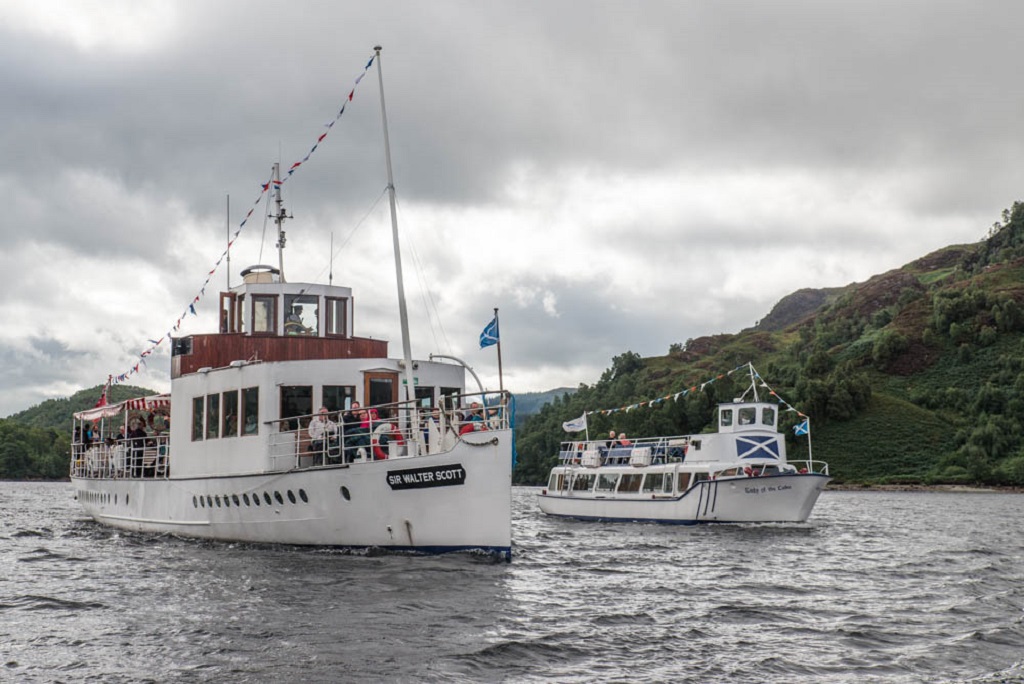
Marking 160 years of an important landmark
The 160th anniversary of the Katrine Aqueduct, one of Scotland’s most important pieces of infrastructure, was marked this week with a special re-enactment of its official inauguration by Queen Victoria.
Actors donned Victorian attire and a modern-day lookalike ‘Queen Victoria’ followed in the footsteps of the monarch and repeated her words close to the very spot, on the south shore of picturesque Loch Katrine, where she opened the mega-structure on October 14, 1859.
The aqueduct, which takes water from the loch to treatment works that supply 1.3 million people in Glasgow and west central Scotland and is a key part of Scottish Water’s network, was built in the Victorian era to help transform the health of citizens and it continues in full use to this day.
Its importance to Scotland, and its stature as one of the world’s greatest feats of engineering of its day, were celebrated when the modern-day ‘Queen Victoria’ stood above the entrance to the aqueduct near Stronachlachar where thousands of people, dignitaries and workers who had built the aqueduct gathered to watch history be made in 1859.
An actress playing the part of Queen Victoria helped recreate the historic scene by repeating the words of Her Royal Highness when she told her audience: “It is with much gratification that I avail myself of this opportunity of inaugurating a work which, both in its conception and its execution, reflects so much credit on its promoters, and is so calculated to improve the health and comfort of your vast population, which is rapidly increasing round the great centre of manufacturing industry in Scotland.
‘Such work is worthy of the enterprise and philanthropy of Glasgow and I trust it will be blessed with complete success. I desire that you convey to the great community which you represent my warmest wishes for their continued prosperity and happiness.”
The commemoration of the official opening today included three special public sailings of the vessels the SS Sir Walter Scott and the Lady of the Lake by the Steamship Sir Walter Scott Ltd from Trossachs Pier to Stronachlachar.
The steamship SS Sir Walter Scott, which has been sailing on the loch for more than a century, was named after the writer who set his 1810 poem Lady of the Lake and his 1818 novel Rob Roy, around Loch Katrine.
During the sailings, the actors portraying Queen Victoria and Prince Albert, and members of the Forest Theatre Company from Gartmore dressed in period costume, gave interactive performances and told passengers about the history and heritage of the area and the aqueduct.
Billy Petrie DL OBE, Chair, Sir Walter Scott Steamship Trust, said: ‘We are delighted to be hosting these special sailings, and the re-enactment with ‘Queen Victoria’ at the Katrine Aqueduct, to commemorate such a hugely important occasion in the history of Glasgow.
‘Apart from being a very beautiful loch in the heart of the Trossachs and the birthplace of tourism in Scotland thanks to Sir Walter Scott’s blockbuster of its day, the Lady of the Lake, Loch Katrine and the aqueduct play a central role in the everyday life of the Glasgow area.
‘So it’s only right that we pay tribute to the talented engineers of the Victorian age whose work enabled clean water to flow from loch to city.
‘The special sailings we’ve put on today, with the actors providing a bit of colour and fun, is a fitting and entertaining way to pay tribute to just what a remarkable feat the construction of the aqueduct was.’

The Sir Walter Scott Steamship (left) and Lady of the Lake on Loch Katrine
Gary Caig, Scottish Water’s water operations manager west, said: ‘The Katrine Aqueduct was fit for a queen then and is still now and remains a hugely important part of our infrastructure so we are really excited to be involved in this celebration of its formal opening.
‘The aqueduct has certainly, in Queen Victoria’s words, ‘improved the health and comfort of the city’s vast population’ and continues to do so to this day.
‘And, with climate change and sustainability being so important in the 21st century, it is still as efficient and environmentally-friendly now as it was then because it takes water by gravity – without the need for pumping – from Loch Katrine to the Milngavie and Balmore water treatment works before it is distributed to customers across a large swathe of Greater Glasgow and west central Scotland.’
The Katrine Aqueduct comprises two aqueducts that are 25.75 miles and 23.50 miles in length from the loch to Milngavie north of Glasgow, which together can provide about 120 million gallons of water every day.
The first was built to give Glasgow a proper water supply and tackle cholera and includes tunnels through mountainous terrain in the shadow of Ben Lomond and bridges over river valleys. The second was constructed to accommodate the rapid expansion of Glasgow, the ‘second city of the Empire’, in the late 19th century.
The entire Katrine Aqueduct scheme cost £3.2m to build, which would be about £320m in today’s prices.
It currently supplies about 110 million gallons of water per day to the two water treatment works and it takes the water about 14 hours to travel along the aqueduct from Loch Katrine to the water treatment works.
A forgotten treasure trove of Victorian photographs showing the construction of parts of the aqueduct was discovered recently.
The glass photograph slides, which had not been seen before by Scottish Water experts with decades of experience of working on the local network, were found along with some books and drawings when the utility was closing one of its offices.
Scottish Water is working on a £15.7m million project to refurbish part of the overall aqueduct scheme at the moment. The project includes structural repairs of three stretches of tunnel and a bridge, improvements to the lining of tunnels and repairs and refurbishments of control valves.
TAGS

